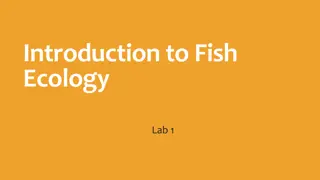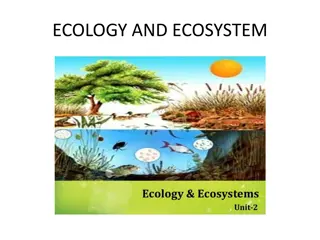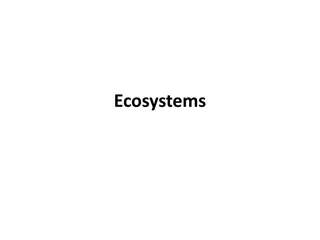Understanding Ecology and Ecosystems
Discover the definitions and concepts of ecology, ecosystems, biosphere, habitats, and niches. Learn how living organisms interact with each other and their environment, explore different types of ecosystems, and understand the global ecosystem known as the biosphere.
Download Presentation

Please find below an Image/Link to download the presentation.
The content on the website is provided AS IS for your information and personal use only. It may not be sold, licensed, or shared on other websites without obtaining consent from the author. Download presentation by click this link. If you encounter any issues during the download, it is possible that the publisher has removed the file from their server.
E N D
Presentation Transcript
1.4.1 4 + 7 Ecology, Ecosystem, Biosphere, Habitat & Niche
Need to know 1. Define the term: ecosystem. 2. Name a range of ecosystems 3. Explain the term: biosphere. 4. Define the term: habitat. 5. Name examples of habitats. 6. Explain the term niche and give examples. 2
What is Ecology? Ecology is the study of how living things relate to each other and to their environment Their environment refers to all the conditions in which the organism lives, which affect the growth and development of the organism. 3
What is an Ecosystem? An ecosystem is a community of living organisms interacting with one another and their non-living environment within a particular area. The earth itself is a true ecosystem as no part of it is completely isolated from the rest. Ecosystem = Communities + Environment 4
Learning check What is ecology? Ecology is the study of how living things relate to each other and to their environment 5
Diversity of ecosystems Woodland, Seashore, Grassland, Hedgerow, Marine, Freshwater, Tree, etc. Can you name some more? Ecosystems can be very large 6
To study an ecosystem We divide the ecosystem into a number of smaller, more manageable areas (habitats). Individual habitats are then studied. 7
Learning check What is an ecosystem? An ecosystem is a community of living organisms interacting with one another and their non-living environment within a particular area. 8
What is the Biosphere? The biosphere is that part of the earth inhabited by living organisms, including land, ocean and the atmosphere in which life can exist. It is the global ecosystem. 9
Biosphere 10
Relationships in the biosphere Biosphere The Biosphere is made up of ecosystems Ecosystems are made up of communities of organisms and the environment Ecosystems Communities are made up of populations of different species of organisms Communities 11
Learning check What is the biosphere? The biosphere is that part of the earth inhabited by living organisms, including land, ocean and the atmosphere in which life can exist. It is the global ecosystem. 12
What is a Habitat? A habitat is the particular place within the ecosystem where an organism lives and to which it is adapted As a living organism (you) what is your Habitat, Ecosystem and Biosphere? 13
Summary Biosphere = that part of the earth and its atmosphere in which life can exist composed of ecosystems Ecosystems = composed of communities of organisms and their environment Communities = populations of different species of organisms Habitats = is the place where an organism lives and to which it is adapted 14
Learning check What is a habitat? A habitat is the particular place within the ecosystem where an organism lives and to which it is adapted. 15
Simple Definition A niche is the functional role of an organism in an ecosystem. 16
Explanation of Niche A niche is a term describing the relational position of a species or population in an ecosystem. 17
Learning Check What is meant by a niche? A niche is the functional role of an organism in an ecosystem. 18
Lichens Two lichens on a rock, in two different ecological niches. Can you explain why they are different niches? Lichenes on a rock Author: Johann Dr o 19 Date: 2005, august, 10
Summary For a species to maintain its population, its individuals must survive and reproduce. Certain combinations of environmental conditions are necessary for individuals of each species to tolerate the physical environment, obtain energy and nutrients, and avoid predators. 20























